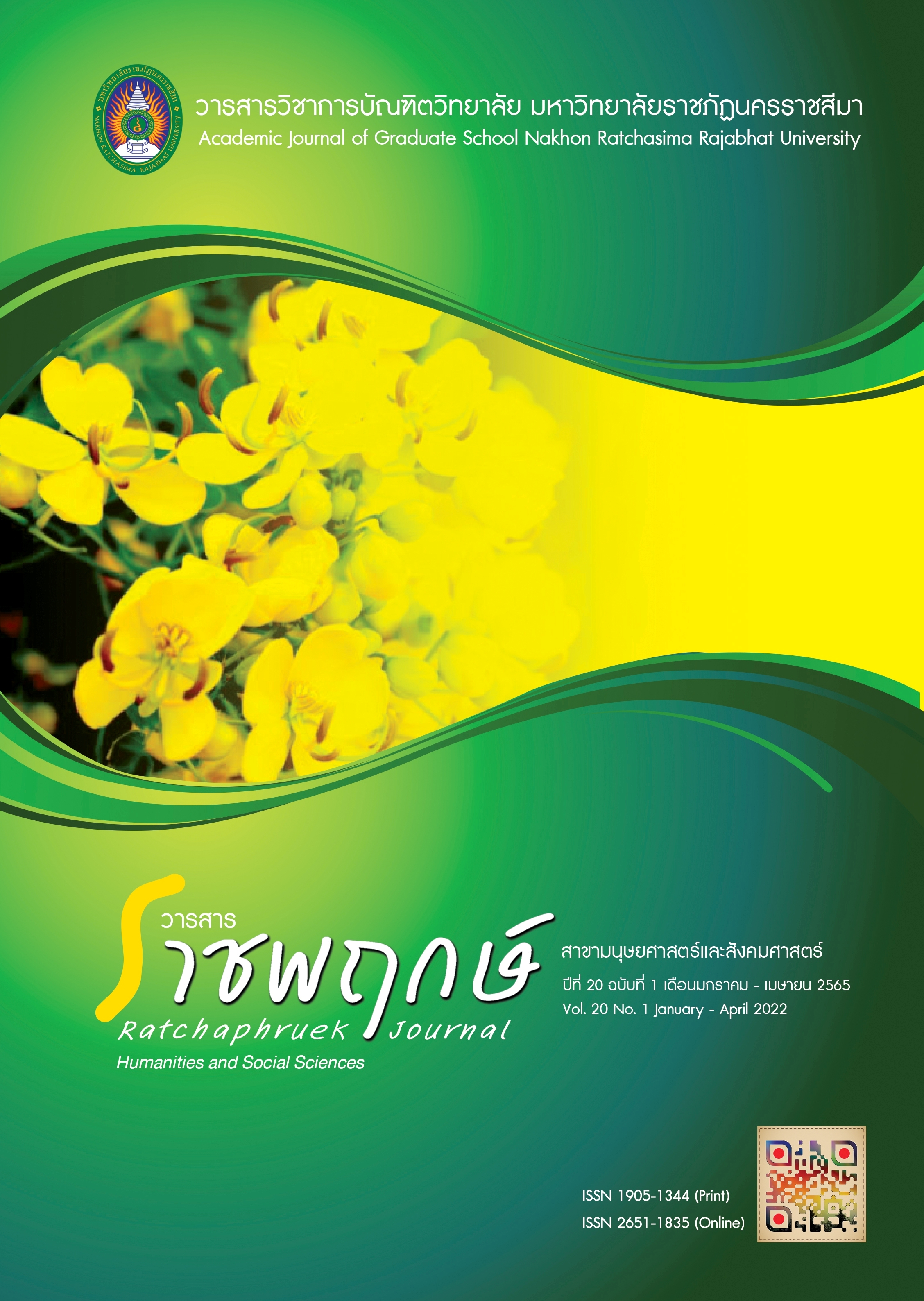การจัดการเรียนรู้ฐานสมรรถนะ เพื่อพัฒนาผลสัมฤทธิ์ทางการเรียน และทักษะการคิดอย่างมีวิจารณญาณ สำหรับนักเรียนชั้นมัธยมศึกษาปีที่ 4
Main Article Content
บทคัดย่อ
การวิจัยนี้เป็นการศึกษาผลสัมฤทธิ์ทางการเรียนและทักษะการคิดอย่างมีวิจารณญาณ โดยการจัดการเรียนรู้ฐานสมรรถนะของนักเรียนชั้นมัธยมศึกษา โดยมีวัตถุประสงค์เพื่อ 1) เปรียบเทียบผลสัมฤทธิ์ทางการเรียนจากการจัดการเรียนรู้ฐานสมรรถนะ ก่อนและหลังเรียนและหลังเรียนกับเกณฑ์ร้อยละ 70 และ 2) เปรียบเทียบทักษะการคิดอย่างมีวิจารณญาณก่อนและหลังเรียน กลุ่มตัวอย่างที่ใช้ เป็นนักเรียนชั้นมัธยมศึกษาปีที่ 4/5 ภาคเรียนที่ 2 ปีการศึกษา 2563 โรงเรียนสุรนารีวิทยา จังหวัดนครราชสีมา จำนวน 40 คน ได้มาโดยการสุ่มแบบกลุ่ม เครื่องมือที่ใช้ในการวิจัย ได้แก่ แผนการจัดการเรียนรู้ฐานสมรรถนะ แบบวัดผลสัมฤทธิ์ทางการเรียน และแบบวัดการคิดอย่างมีวิจารณญาณ สถิติที่ใช้ ได้แก่ ค่าเฉลี่ย ร้อยละ ส่วนเบี่ยงเบนมาตรฐาน และการทดสอบค่าที
ผลการศึกษา พบว่า 1) ผลสัมฤทธิ์ทางการเรียนของนักเรียนชั้นมัธยมศึกษาปีที่ 4 จากการจัดการเรียนรู้ฐานสมรรถนะ หลังเรียนสูงกว่าก่อนเรียน และสูงกว่าเกณฑ์ร้อยละ 70 อย่างมีนัยสำคัญทางสถิติที่ระดับ .05 และ 2) นักเรียนมีทักษะการคิดอย่างมีวิจารณญาณ หลังเรียนสูงกว่าก่อนเรียน อย่างมีนัยสำคัญทางสถิติที่ระดับ .05
Article Details

This work is licensed under a Creative Commons Attribution-NonCommercial-NoDerivatives 4.0 International License.
References
กระทรวงศึกษาธิการ. (2551). หลักสูตรแกนกลางการศึกษาขั้นพื้นฐาน พุทธศักราช 2551. กรุงเทพฯ: ชุมนุมสหกรณ์แห่งประเทศไทย.
กิติพงษ์ ลือนาม. (2561). วิธีวิทยาการวิจัยทางการศึกษา. นครราชสีมา: โคราชมาร์เก็ตติ้ง แอนด์ โปรดักชั่น.
ชนธี ชำนาญกิจ. (2560). การพัฒนาหลักสูตรฝึกอบรมฐานสมรรถนะทางด้านการใช้ภาษาไทย เพื่อเตรียความพร้อมในการสหกิจศึกษา โดยใช้รูปแบบการเรียนรู้แบบร่วมมือและแนวคิดการสอนภาษาเพื่อการสื่อสาร (วิทยานิพนธ์ดุษฎีบัณฑิต, มหาวิทยาลัยบูรพา).
ประพันธ์ศิริ สุเสารัจ. (2556). การพัฒนาการคิด (พิมพ์ครั้งที่ 8). กรุงเทพฯ: 9119 เทคนิคพริ้นติ้ง.
พิชิต ฤทธิ์จรูญ. (2551). หลักการวัดและประเมินผลการศึกษา (พิมพ์ครั้งที่ 4). กรุงเทพฯ: เฮ้าส์ออฟเคอร์มีสท์.
สถาบันทดสอบทางการศึกษาแห่งชาติ (องค์กรมหาชน). (2562). ผลการทดสอบทางการศึกษาระดับชาติ(O-NET) ปีการศึกษา 2560-2562. สืบค้นเมื่อ 7 พฤศจิกายน 2563, จาก http://www.newonetresult.niets.or.th
สมบูรณ์ ตันยะ. (2556). วิธีวิทยาการวิจัยทางการศึกษา. นครราชสีมา: คณะครุศาสตร์ มหาวิทยาลัยราชภัฏนครราชสีมา.
สริญญา มารศรี. (2562). การพัฒนาทักษะการคิดอย่างมีวิจารณญาณ ในศตวรรษที่ 21 Developing Critical Thinking Skills in the 21st Century. วารสาร มจร นครน่านปริทรรศน์, 3(2), น. 105-122.
สิรินาถ จงกลกลาง. (2564). การออกแบบการเรียนรู้ตามแนวทางการจัดการศึกษาที่เน้นผลลัพธ์การเรียนรู้สู่สมรรถนะ [เอกสารประกอบการบรรยาย]. นครราชสีมา: คณะครุศาสตร์ มหาวิทยาลัยราชภัฏนครราชสีมา.
สุคนธ์ สินธพานนท์. (2558). การจัดการเรียนรู้ของครูยุคใหม่...เพื่อพัฒนาทักษะของผู้เรียนในศตวรรษที่ 21. กรุงเทพฯ: 9119 เทคนิคพริ้นติ้ง.
สิทธิเดช สอนจังหรีด และสิรินาถ จงกลกลาง. (2560). การศึกษาผลสัมฤทธิ์ทางการเรียนหน่วยการเรียนรู้พินิจวรรณกรรม และการคิดอย่างมีวิจารณญาณ ของนักเรียนชั้นมัธยมศึกษาปีที่ 6 จากการจัดการเรียนรู้ด้วยเทคนิคการคิดแบบหมวกหกใบ. วารสารราชพฤกษ์, 15(1), น. 88-95.
สำนักงานเลขาธิการสภาการศึกษา. (2562ก). เข้าใจสมรรถนะอย่างง่ายๆ ฉบับประชาชน และเข้าใจหลักสูตรฐานสมรรถนะอย่างง่ายๆ ฉบับครู ผู้บริหาร และบุคลากรทางการศึกษา. กรุงเทพฯ: 21 เซ็นจูรี่.
________. (2562ข). แนวทางการพัฒนาสมรรถนะผู้เรียนระดับการศึกษาขั้นพื้นฐาน. กรุงเทพฯ: 21 เซ็นจูรี่.
________. (2563). การจัดการเรียนรู้ฐานสมรรถนะเชิงรุก. กรุงเทพฯ: 21 เซ็นจูรี่.
Soares, L. (2012). A ‘Disruptive’ Look at Competency-Based Education. Retrieved October 10, 2020, from https://www.americanprogress.org/issues/educationpostsecondary/reports/2012/06/07/11680/a-disruptive-look-at-competency-based-education/
Walton, J. (2017). Competency-Based Education: Definitions and Difference Makers. Retrieved May 9, 2021, from https://www.gettingsmart.com/2017/12/competency-based-education-definitions-and-difference-makers/

